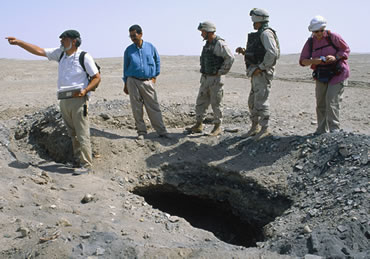|
New Scientist magazine (12/06/2003)
Looters digging for
treasure have riddled ancient sites in southern Iraq with holes,
according to the first major survey since the end of war. Tens
of thousands of artifacts are feared lost and the destruction
has obliterated much of the archaeological value of the sites.
The damage is uneven.
Northern sites such as the former Assyrian capitals of Nineveh
and
Nimrud were guarded suffered only minor vandalism and a
handful of holes dug in search of gold and other valuable artifacts.
But Gibson
found serious damage at 10 of the 13 southern sites he visited by
helicopter.
The looters left uncounted artifacts from some of the world's earliest civilizations strewn on the ground. These included cuneiform tablets, stone tools and copper and bronze implements. Although some were intact, they had lost their context and much of their scientific value.
Eight of 10 southern sites visited by Elizabeth Stone of the State University of New York at Stony Brook had suffered some looting. The well-studied sites of Babylon, Ur, and Nippur fared better than little-known spots. Both Babylon and Ur are now guarded by US troops occupying nearby bases.
Money laundering and corruption
The survey team made three recommendations to stop the destruction:
In Baghdad, curators at
the
Iraqi National Museum have now confirmed that well
over a thousand missing pieces are missing, but the final tally
will be much higher. Early reports that thieves had taken only 33
artifacts counted only large objects left in display cases.
(Multimedia: Map
with Iraq's threatened Heritage - "click"
HERE)
|

